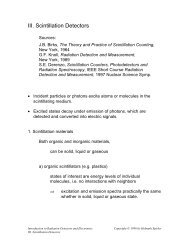Introduction to radiation-resistant semiconductor devices and circuits
Introduction to radiation-resistant semiconductor devices and circuits
Introduction to radiation-resistant semiconductor devices and circuits
You also want an ePaper? Increase the reach of your titles
YUMPU automatically turns print PDFs into web optimized ePapers that Google loves.
Ionization Damage<br />
As in the detec<strong>to</strong>r bulk, electron-hole pairs are created in the oxide. The electrons<br />
are quite mobile <strong>and</strong> move <strong>to</strong> the most positive electrode. Holes move by a rather<br />
complex <strong>and</strong> slow hopping mechanism, which promotes the probability of trapping<br />
in the oxide volume <strong>and</strong> an associated fixed positive charge. Holes that make it <strong>to</strong><br />
the oxide-silicon interface can be captured by interface traps. This is illustrated in<br />
Fig. 2, which shows a schematic cross-section of an n-channel MOSFET. A positive<br />
voltage applied <strong>to</strong> the gate electrode attracts electrons <strong>to</strong> the surface of the<br />
silicon beneath the gate. This “inversion” charge forms a conductive channel<br />
between the n+ doped source <strong>and</strong> drain electrodes. The substrate is biased negative<br />
relative <strong>to</strong> the MOSFET <strong>to</strong> form a depletion region for isolation. Holes freed<br />
by <strong>radiation</strong> accumulate at the oxide-silicon interface. The positive charge buildup<br />
at the silicon interface requires that the gate voltage be adjusted <strong>to</strong> more negative<br />
values <strong>to</strong> maintain the negative charge in the channel.<br />
Trapped oxide charge can also be mobile, so that the charge distribution generally<br />
depends on time, <strong>and</strong> more specifically, how the electric field in the oxide<br />
changes with time. The charge state of a trap depends on the local quasi Fermi<br />
level, so the concentration of trapped charge will vary with changes in the applied<br />
voltage <strong>and</strong> state-specific relaxation times. As charge states also anneal, ionization<br />
FIGURE 2. Schematic cross section of an n-channel MOSFET (left). A detail of the gate<br />
oxide shows the trapped holes at the oxide-silicon interface (right).<br />
6





